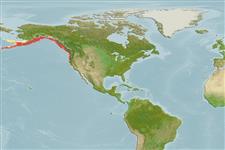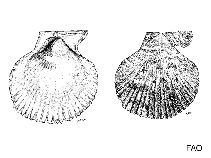Patinopecten caurinus (Gould, 1850)
Giant Pacific sea scallop| Native range | All suitable habitat | Point map | Year 2050 |

|
| This map was computer-generated and has not yet been reviewed. |
| Patinopecten caurinus AquaMaps Data sources: GBIF OBIS |
Изображение на Google | No image available for this species;
drawing shows typical species in Pectinidae.
Классификация / Names народные названия | синонимы | CoL | ITIS | WoRMS
Bivalvia | Pectinida | Pectinidae
Environment: milieu / climate zone / пределы глубины / distribution range экология
; пределы глубины 2 - 300 m (ссылка 114301), usually 60 - 120 m (ссылка 114306). Temperate, preferred 7°C (ссылка 107945); 64°N - 36°N, 179°W - 120°W
Distribution страны | регионы FAO | Ecosystems | места находок | интродукции
Eastern Pacific: From Pribilof Islands, Alaska to Point Sur, California, USA. Temperate to boreal.
Length at first maturity / Size / Weight / Возраст
половая зрелость: Lm ? range ? - ? cm Max length : 28.0 cm SHL самец/пол неопределен; (ссылка 95344); наибольший возраст (опубликованны данные): 15 годы (ссылка 8702)
Life cycle and mating behavior половая зрелость | размножение | нерест | Eggs | Fecundity | Larvae
Основная ссылка
ссылки | координатор | соавторы
Ignell, S. and E. Haynes 2000 Geographic patterns in growth of the giant Pacific sea scallop, Patinopecten caurinus. Fish. Bull. 98:849-853. (ссылка 386)
Статус Красного Списка МСОП
(ссылка 130435: Version 2025-1)
Статус СИТЕС (ссылка 108899)
CMS (ссылка 116361)
Угроза для людей
Использование человеком
рыболовство: коммерческий
FAO - рыболовство: landings | FishSource | Sea Around Us
инструменты
дополнительная информация
ресурсы в Интернет
BHL | BOLD Systems | CISTI | DiscoverLife | FAO(рыболовство: ; publication : search) | Fishipedia | GenBank (Геном, Нуклеотид) | GloBI | Gomexsi | Google Books | Google Scholar | Google | PubMed | Tree of Life | Wikipedia (Вперёд, поиск) | Zoological Record



